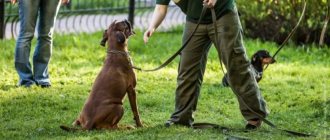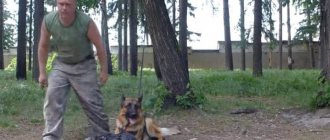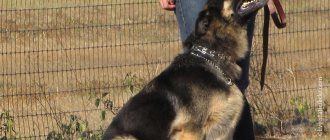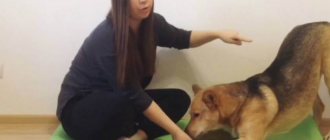- 22.02.2017
- Videos, Training, Dogs, Articles, Explanatory
Owners of “serious animals” are often condescending towards the desire of novice dog breeders to teach their pet the “give paw” command, considering it meaningless and useless. Our article will dispel this misconception, tell you in detail how to teach your dog the “give paw” command and explain why it is so important.
Whose paw is better: who suits the team
“Give me your paw” is a phenomenal command: it is not included in any training course standards, but in terms of popularity it is on the list of leaders (after “sit” and “come”). The secret is very simple, “give me a paw” is a simple and universal element of trick training, equally suitable for both the rugged mastiff and the tiny Chihuahua.
Offer of paw and heart: why is the command to give paw needed?
- A dog of any size needs to feel “good and needed . Owners of decorative babies and companion animals sometimes do not attach importance to this component of dog happiness. The skill of giving a paw is as important for a small dog as it is for sled dogs to pull a sleigh or for hunting breeds to fetch game. In human translation it sounds something like this: “I can do something. This means I have meaning in life.”
- The learning process strengthens the emotional connection between the animal and the person, increases the owner’s authority and is the key to discipline. Giving a paw and leaving it in the owner’s hand is also one of the signs of the pet’s trust.
- Some dog owners use the command to inspect pads for damage, trim nails, or perform hygiene procedures. We recommend that you come up with your own speech markers for each action (for example, “let me look, cut my hair, wash it”). “Give me your paw” is a separate requirement and its auxiliary use is possible only in the first stages. The more words the dog learns, the better.
- Four-legged pets tend to “raise their paw” at a person, demanding attention or delicacies . Animal psychologists suggest that in this way dominant individuals are trying to increase their hierarchical status, and recommend taking control of the process - developing the habit in the dog of performing actions only on command.
- A simple trick can be the first step towards more complex elements . Dogs love to learn and the success of their tailed charge depends only on the owner.
Exercises to consolidate knowledge
To develop and consolidate a skill, you need regular and spontaneous training of a reflexive reaction. That is, in addition to planned training in a serious environment, it is important to use the command in everyday life.
The sudden “Give me a paw” exercise is considered effective, for example, in the morning when the pet has just woken up; during the day, when the owner was simply passing through or returning home. It is important to experiment; the dog should give the limb, even when the person is lying or sitting.
Commands on different paws are reinforcing and developing. The owner asks to serve the right and left limbs alternately, with a frequency of 1 execution every 2-3 seconds.
General rules for self-training a dog
By properly raising and training a dog, the owner becomes for it the most important creature in the world, a source of emotions and new knowledge. Such trust is priceless. The better you cope with the role of leader, the more successful your further training will be. How to teach a dog to give paw? You will need desire, time, patience and our advice from a professional dog handler .
Calm, just calm
- The main instrument of influence is the voice . The command is given in an even, calm tone, each with its own intonation. The dog does not yet understand your words literally, but reacts to the sound.
- Never yell at your dog. You can’t take your irritation out on her if something doesn’t work out at all. The dog will become isolated and will only work worse. It is the tone that affects, not the volume. Severity and anger are two different things.
- You cannot hit a dog for not following commands! Your four-legged friend should respect you, not fear you. Doesn't obey? You are making a mistake somewhere. The main credo of proper training is persistence without violence.
- You can give the same command no more than twice . The demand has been made - achieve its fulfillment. You are much more cunning and smarter than your pet. Careful observation of the animal will help you choose the appropriate tactics.
- Undesirable behavior is stopped using safe words (no, bad), spoken calmly but sternly.
A kind word pleases the dog too
- Praise from the bottom of your heart for correct behavior even in small things. Come up with a few “reward markers” (well done, good, bravo).
- You should not pat the animal on the head or ruffle the dog. Some four-legged students perceive rough petting as violence.
- The lesson should end on a positive note. For example, by following a favorite, well-practiced command and sincere encouragement from the owner.
- Always have a treat on hand. Don’t be afraid that the dog will start to cheat and work only for treats. The need for food rewards will disappear over time. The treat is given immediately after the order is completed, along with praise. It is advisable to pronounce the command so that the dog understands why he is being praised (“okay, give me your paw, okay”).
Not a moment of peace
- Before starting work, let the animal run around a little. Alternate training and “unloading”. We worked, played or walked. The dog should not get tired from training. If you notice that your pet has become distracted and has difficulty concentrating, it’s time to end it.
- Training should be approached in stages (mastered one technique, proceed to the next). A new element is introduced after familiar ones have been practiced, but not at the very end of the lesson.
- To increase motivation , older dogs are trained 6-8 hours after feeding. But the main criterion is that the pet must be actively interested in receiving the treat.
- Show kindness and energy. If you start exercising without desire or in a bad mood, your dog will feel the same.
- By training a dog from time to time, you run the risk that it will obey you sporadically: when it wants. Only repeated repetitions form stable skills. Communicate with your pet as much as possible. You will not regret it and as a result you will get a four-legged friend who understands everything perfectly.
Rules for conducting a training program
In upbringing, the owner needs to show firmness, but restraint. It is unacceptable to use harsh words or apply physical force. Professionals recommend adhering to the basic rules necessary for any training program:
- The voice is strict, firm, confident and loud . The dog must feel the strength of the owner and respect him. Each command must be different in intonation so that the animal can distinguish one word from another. Screaming and swearing are prohibited.
- The signal is pronounced 1-2 times, it is important to achieve compliance . If the pet does not understand, he is helped by demonstrating with another dog or on his own. It is important to reward any successful action.
- If a pet is playing around and doesn’t listen, he is pacified with the safe words “enough”, “quiet”, “bad”, “no”. You cannot hit an animal.
- Regular and systematic training is important. You can move on to another command only after practicing and memorizing the first one.
- Before training, the animal must run and burn off energy; if the pet is tired, the program is ended.
Praise needed:
- firstly, the tone changes to friendly;
- secondly, soft, affectionate words are used;
- thirdly, a portion of treats is given.
At what age to start training
Dogs of any age category , but for a positive result it is important to take into account the characteristics of each group.
- Training of puppies from 1.5 to 3 months is carried out exclusively in a playful way with a minimum number of repetitions (3-5 times). This is not a waste of time, as many people think, but a useful and exciting activity for both. By three months, the baby is quite capable of mastering such useful skills as “sit”, “come to me”, “give me a paw”, and get used to a collar and leash.
- From 4 months onwards the real dog school begins. Everything here is like with people: there are primary classes, middle classes and senior groups. The older the puppy becomes, the more serious the requirements and the stricter the trainer.
- There are situations when an adult dog comes into the house that has never been handled. Of course, it’s sad if the most productive period of upbringing is missed, but this is not a reason to give up. It is possible and necessary to work with an adult dog. It just takes more time, patience, and repetition to achieve results.
Possible mistakes
Trying to be consistent and persistent in training, a person often makes mistakes that can completely discourage a pet from learning something. The most serious include:
- when demonstrating the exercise, the owner raises the pet’s paw too much, thereby frightening it;
- commands by raising his voice or in a nervous tone, which also irritates the student;
- classes begin at the beginning of the walk, when the pet is not in the mood for training, or the training is delayed, thereby tiring the animal:
- trying to experiment, the owner changes voice commands too often or alternates commands with voice and gestures, which is why the dog gets confused and ceases to understand what is expected of him.
Important! If a pet refuses to obey a command not given by its owner, this does not mean that it has forgotten it. It is quite possible that the “stranger” modified the text or that this person is simply unpleasant to the dog.
Before you start teaching your dog to perform a new action, you should decide whether it is necessary for a particular pet. Ignorance of the “give paw” command does not in any way affect the dog’s life. But it should be noted that this skill sets the dog apart from the rest.
How to teach a dog to give paw: three main ways
Learning will go faster if your pet first learns the “sit” command. This will make it easier for you to keep his attention. Sit the dog in front of you (if we are talking about a puppy or small dog, squat down to be on the same level as your pet). The student must focus on your actions. To do this, you can snap your fingers and make an unusual sound.
When the goal is achieved, start the lesson. To teach your dog a command, we recommend using one of the presented methods of your choice.
Pointing method
The essence of the method is to evoke the desired behavior in the animal using treats or gestures.
- show the dog a treat;
- make sure the student is interested in receiving encouragement;
- hold the piece in the fist of your left hand and bring it to the dog’s nose;
- do not unclench your hand, stopping the gourmand’s attempts to reach the food with his nose;
- voice the demand “give me your paw”;
- at the moment when the dog lifts it to get the treasured piece, place your right hand, as if the dog itself had put its paw in it, and unclench the fist with the food;
- At the same time, enthusiastically praise your pet: “ok, give me your paw, good.” Show as many positive emotions as possible. And let others think you are crazy. Your goal is to make the learning process enjoyable for your dog.
Passive inflection method
A fairly effective method if the animal does not experience negative emotions from the impact. The trainer “sculpts” the desired pose of the dog with hand movements.
- after showing the dog a treat (interesting in the result), give a command;
- lift the dog’s paw with your hand, fix the pose;
- give a treat, praise.
The paw should not be lifted too high (up to the level of the animal’s shoulder is quite enough) or squeezed too hard. Any unpleasant sensations can cause a four-legged student to have a negative attitude towards the team.
Behavior selection method
How to teach a dog to give a paw without resorting to training? Pay attention to this method. It consists of encouraging behavior that is useful to the trainer in various everyday situations.
- For example, a dog wants to play and touches you with its paw. Before he repeats this gesture himself, give the command;
- put your hand on your paw and give it a treat and praise.
Recommendations
The process of training a dog can take place anywhere - in the house, on a country plot, during a walk in a public garden or park, on special sports grounds. It is important that the pet and owner are in the best possible mood. You cannot use rudeness or corporal punishment towards Yorkies. A loud voice and screaming are unacceptable, but excessive tenderness and baby talk will not lead to anything good. It is recommended to encourage the dog in a cheerful voice and treat it with treats if the commands are successfully completed.
Expert opinion
Anna Abramenko
An avid dog lover. Experience in veterinary medicine since 2009.
Ask a Question
The training should not be too long, as the small pet gets tired quickly. 10-15 minutes a day is enough to successfully teach a Yorkie the basic commands.
Raising and training a Yorkie boy is slightly different from the same processes for a girl. Males are more inquisitive, love to catch prey, frolic, are prone to disobedience, the owner will need to show persistence and severity. Females are distinguished by affection and flexible character.
How to teach a dog to give the other paw
It is enough to show a little patience, and soon your pet will delight you with its successes. But don't rush to relax. Only when the dog learns to give both paws in turn is the command considered mastered. So let's move on.
- practice a trick you’ve already learned, praise your pet;
- show the treat and say “give me another”;
- the dog, out of habit, will try to hand you the same limb;
- show that now you need something different (for example, “no, give me something else”);
- tell the dog the correct action (touch the desired paw with your finger or use the sculpting method - lift it yourself);
- At first, the dog may get confused: give the same limb several times or perform a connection without waiting for the command “give another.” Gently correct the student using safe words (no, don’t) and praise only for correct actions.
"Tasty" reward
To begin with, the dog must be seated using the abrupt word “Sit!” If the animal has not yet been trained in this order, light pressure should be applied to the back, in the area next to the tail, so that it understands what position it needs to take. The distance between the animal and the owner should be small, because they will have to reach out to each other quite often.
The method, in which treats play a key role, is perfect for babies or adults with a pronounced temperament. Starting position: the pet is sitting, his trainer is standing. The mentor brings the fist with the “sweetness” clamped to the pet’s nose in order to let the animal smell the delicious smell.
The dog will instinctively hit the hand, and the person will have to have time to grab the limb extended by the dog and hold it in this position for several seconds. At the same time, you will need to loudly and clearly pronounce the phrase “Give me your paw!” After this, the “student” needs to be praised and rewarded with a treat, and then the procedure must be repeated several times.
The dog has learned to give its paw: what next?
There are as many methods of training and types of tricks as a trainer can come up with. If you are interested in further developing the skills of a four-legged artist, we advise you to learn other interesting elements, the basis for which is the simple ability to give a paw.
- “high five” - raising its paw high, the dog touches the owner’s open palm with it;
- “give both” - the dog gives both paws at the same time;
- “ladushki” is a funny element that imitates a child’s game;
- “hold” - after raising the paw, the animal keeps it suspended;
- “Give me the back” is not the most convenient trick for a dog to perform from a standing position;
- “Spanish step” - the tailed comrade strides, raising his front paws high. It's hard to believe that performing this difficult element of freestyle (dancing with dogs) is impossible without the ability to give a paw. But, who knows, maybe your pet will become a star not only in a narrow family circle, but also at prestigious sporting competitions?
Without an appetizing piece (mechanical method)
Is it possible to train a dog to give a paw without the help of food, and how to achieve this? The first thing to consider: this method is only suitable for an adult or an active sanguine puppy that does not need additional motivation.
The starting position remains unchanged. The trainer takes the dog's paw in his hand, clearly pronounces the order and praises the animal. After this, a short break is taken, and then the approach is performed again.
Important! In order to avoid injury, the dog’s paw must be raised low from the ground, and also ensure that it bends like a human elbow and only at a right angle.
Of course, this path will be more time-consuming, however, following it, you can be confident in the pet’s obedience, its ability to obey and learn.
Characteristics of Spitz
It is impossible to raise an obedient Spitz without understanding his psychology and temperament. First of all, it is worth learning that a dog thinks differently than a person. She does not build complex logical chains; she acts based on innate instincts and acquired reflexes.
It is on instincts and reflexes that the education of a Spitz is based. It is necessary to develop the dog’s natural qualities and build the right associations: “a good deed is reward”, “a bad action is punishment”.
The Pomeranian is an open, intelligent dog that quickly learns commands and tries to please its owner. Anyone can handle her training. But sometimes education stalls, and the dog turns into a spoiled tyrant.
The reasons for unsuccessful training lie in the disadvantages of the Spitz’s character. They:
- Stubborn. Favorites stand their ground to the last, and obey only when they understand that the owner will not back down;
- Dominant. If trained incorrectly, the pet will imagine itself to be in charge and will do everything to make the owner’s life revolve around its desires;
- Manipulators . In this, dogs have no equal, they subtly feel people’s emotions, understand how amazing they are and take advantage of it.
The German Spitz is an artist like no other. The dog skillfully presses on pity, guilt, and love of the owner. Among the manipulator's arsenal:
- sad or begging faces;
- grievances - going to another room, unwillingness to communicate with the owner, refusal to eat, play;
- barking, whining, howling;
- hysterics - Spitz squeal worse than piglets when trying to punish them, send them to their place, fasten a leash and other actions that infringe on the freedom of pets.
Keep in mind that Spitz love to play. Moreover, both puppies and older dogs frolic. Therefore, the classes are made humorous, they are conducted as if by the way.
The character of a German Spitz boy is more dominant and stubborn, while a girl’s character is flexible and affectionate. But both masterfully manipulate people.
Nuances of training
To properly train a German Spitz, you need to follow a number of rules:
- Cruelty is prohibited. Yes, bad behavior needs to be stopped. But a stern tone, a sharp gesture or sound, or pulling the leash will do as punishment. Irritation, shouting, and beating will only intimidate the dog.
- From simple to complex. Training is built from easy to difficult skills. If a skill is difficult, it is broken down into subparts.
- Choose the dog's ideal condition and conditions. Half-starved, walked and played Spitz dogs train better. The first training is carried out in deserted, quiet places.
- First - at home, then - on the street. They start raising a Spitz puppy in an apartment. As soon as he has mastered the skill, they go outside. Here you have to start, essentially, all over again. New places, sounds, smells discourage the pet, he forgets everything he has learned.
- Confident tone. Commands must be given in a stern, loud, commanding voice.
- Voice + gestures. Each voice order is supported by a gesture. So, during the “Sit” command, the palm is placed forward, “Lie down” - accompanied by the hand lowered down.
- “No” to fatigue, “yes” to diversity. The main mistakes of owners is the desire to get everything at once. They spend hours training German Spitz dogs, but to no avail. It is much more useful to train for 5-15 minutes several times a day than one long one. Plus, classes are varied, with game elements, breaks for rest, walks, and fun.
- Don't change the name. The learned “Fetch” cannot be transformed into “Bring”, and “Give” cannot be transformed into “Let”.
- Strangers are not a decree. The German Spitz is taught not to obey strangers, otherwise the dog will follow the first person it meets.
- Praise is everything. There is no point in training a Spitz. But the rewards for mastered skills include praise, toys and treats. Therefore, every correct execution of an order is encouraged.
Training a Spitz can be done by anyone. Even a beginner with no experience with dogs can handle raising this smart cutie. The main thing is not to follow the lead of the charming manipulator and be consistent.
Other useful skills
Commands are only a small part of what needs to be taught to a Spitz. It’s impossible to cover all the skills in one article, but there are key skills that you can’t do without.
Nickname
The first thing a kitten should remember in a new family is its name. It's easy: just repeat the name as often as possible, and after 3-5 days the Spitz will learn it.
It is important that when pronouncing the nickname, the puppy breaks away from his work, turns his head towards the owner and looks into the eyes for a couple of seconds.
Toilet
Until the puppy has learned to tolerate and relieve himself outside, he is taught to go to the toilet in a certain place in the house. The skill will also come in handy for adult German Spitz dogs - they won’t have to wait hours before going for a walk, and in inclement weather they can skip the walk altogether.
For this:
- lay out a dozen moisture-absorbing diapers around the apartment;
- as soon as the kitten spins in one place and sits down, they take him to the nearest toilet, wait until the baby copes, and praise him;
- day by day the number of diapers is reduced until there is only one left;
- after 1-2 weeks it is transferred to a tray;
- Gradually the diaper in the tray is cut off until a small flap remains - and then they throw it away too.
Dogs are not cats. While whiskers learn to go to the litter box in a couple of days at most, Spitz dogs learn this skill in weeks.
Avoid excessive barking
German Spitz are more talkative than a parrot. They bark shrilly and loudly at the slightest provocation. The order “Quiet” will help calm down the flow of words. But it doesn't always work.
You can show that you don’t like yapping:
- leaving the Pomeranian alone;
- stopping barking and scolding the dog at the first yelp;
- distracting your pet with toys and treats;
- sending the pet to its place.
Uncontrollable barking is a sign of anxiety. It will help to exclude him from being examined by a veterinarian for possible diseases, going for a long walk, and solving psychological disorders.
The ability to be alone
German Spitz are very attached to their family, it is difficult for them to stay at home alone. Therefore, when the owners leave, they worry, bark, howl, and spoil things.
In order for the pet to easily tolerate loneliness, it is taught to be alone from puppyhood:
- lock the dog in a separate room;
- as soon as he gets worried, they order “No”;
- if it follows people, they calmly, silently return them to their place.
Such demonstrative abandonment is practiced every day, constantly increasing the time without owners. If a Spitz sits quietly for half an hour, it will withstand many hours of separation.
Socialization
It is impossible to raise a Spitz without socialization. In the family circle, a dog can be three times charming, but if he does not know how to normally relate to strangers, animals, and sudden events, no amount of training will help.
Spitz socialization begins at 3-4 months, when the vaccination quarantine ends. The dog is introduced to:
- children;
- other people's pets;
- unknown adults;
- travel by personal and public transport;
- noisy places;
- veterinary clinics and other institutions that you will have to visit frequently.
When they go out for the first time, they take treats with them. They are fed periodically - this way the dog will not worry and will focus on the owner. It is important to ensure that the Spitz reacts to surrounding people, animals and unfamiliar places without fear or aggression.
Basics of education
The first and main rule for training any dog is to establish hierarchical relationships. Dogs are social animals. And they perceive the family as a pack, where each member will play his role - from the owner to the hamster.
The roles are distributed as follows: alpha - the owner, after him - the spouse, parents, children, then - the rest of the pets, and at the end - the German Spitz. This is the only way the dog will obey.
In order for the dog to consider the owner as the leader of the pack, they follow simple training tips:
- feed the pet after they have eaten themselves;
- a person enters and exits first;
- on a walk, the owner walks ahead - the dog runs slightly behind, does not rush forward, does not pull on the leash;
- you cannot feed the dog from the table, or allow him to sleep on the bed - these are the attributes of a leader;
- when the game starts and ends is determined by the owner;
- biting, snarling, attempts to dominate are stopped immediately and harshly.
The rules are set once and for all. If a Pomeranian is not allowed to lie on the sofa, an exception cannot be made, even if he is sick. What the dog is allowed to do once, he will certainly repeat many times.
A daily routine will help in training a German Spitz. They determine the time of awakening, walks, classes, games, hygiene procedures, feeding, and rest. This makes it easier for your pet to navigate, and he develops the right habits.











